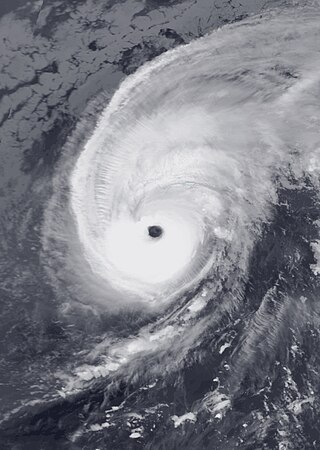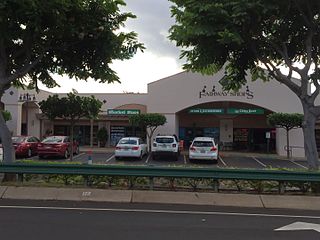
Bermuda is a British Overseas Territory in the North Atlantic Ocean. The Bermuda archipelago consists of 181 islands with a total land area of 54 km2 (21 sq mi). The closest land outside the territory is in the US state of North Carolina, approximately 1,035 km (643 mi) to the northwest.

Great Keppel Island lies 15 kilometres (9.3 mi) from the coast off Yeppoon in the Shire of Livingstone, Queensland, Australia. It is part of the Capricorn Coast of Central Queensland. The island's traditional owners are the Woppaburra people. As the largest of the eighteen islands in the Keppel Group, Wop-Pa covers an area of 1308 hectares. It is within the local government area of Shire of Livingstone.

Dunk Island, known as Coonanglebah in the Warrgamay and Dyirbal languages, is an island within the locality of Dunk in the Cassowary Coast Region, Queensland, Australia. It lies 4 kilometres (2.5 mi) off the Australian east coast, opposite the town of Mission Beach. The island forms part of the Family Islands National Park and is in the larger Great Barrier Reef World Heritage Area.

Lady Elliot Island is the southernmost coral cay of the Great Barrier Reef, Australia. The island lies 46 nautical miles north-east of Bundaberg and covers an area of approximately 45 hectares. It is part of the Capricorn and Bunker Group of islands and is owned by the Commonwealth of Australia. The island is home to a small eco resort and an airstrip, which is serviced daily by flights from Bundaberg, Hervey Bay, Brisbane and the Gold Coast.

The Hamilton Princess & Beach Club, A Fairmont Managed Hotel is one of the grandest and most famous hotels in Bermuda, located in Pembroke Parish just outside the City of Hamilton. It also happens to be the oldest hotel in the Fairmont chains. One of the largest in Bermuda, it has over 400 rooms. It is one of two Fairmont Hotels on the island, the second being the Fairmont Southampton, which was originally opened as the Southampton Princess.

Jungle Island, formerly Parrot Jungle, is a relaunched eco-adventure park on Watson Island, Miami, Florida, United States. The park is re-opened following a series of major renovations after the park incurred damage from Hurricane Irma. The park features new pop-up waterslides, an outdoor wind tunnel flight experience, zip lines, escape rooms, a Nerf battle stadium and other attractions.

The Beach at Adventure Landing was a 35-acre (140,000 m2) water park located 24 miles (39 km) northeast of Cincinnati in Mason, Ohio. Previously known as The Beach Waterpark, it featured ten water attractions, several children's areas, sand volleyball and basketball courts, pool-side beverage service and other special events. The Beach was named the best privately owned water park by Aquatics International Magazine in 2010.
Canadian Forces Station Bermuda, commonly shortened to CFS Bermuda and popularly known as Daniel's Head, was a Canadian Forces Station in Bermuda that was operational from 1963 until 1992. Daniel's Head and Daniel's Island had previously been used by the militia, and the Royal Navy. A previous Canadian base, HMCS Somers Isles, had existed during the Second World War.

Fernance Bento Perry,, was a Portuguese-Bermudian entrepreneur and business leader, who had a prominent role in the economy of Bermuda from the mid-20th century to the time of his death in 2014. Originally from the Azores, his professional career spanned such diverse fields as retail supermarkets, television and radio broadcasting, real estate management and maritime shipping. His philanthropic works contributed to healthcare improvements and programmes of spiritual enrichment in Bermuda. In recognition of his achievements, Perry was appointed a Member of the Order of the British Empire (MBE) in 2007. He died on November 27, 2014, at age 92.

The Reefs Hotel & Club, commonly known as The Reefs, is a luxury four-star resort hotel in Southampton Parish. Bermuda, located next to the Sonesta Beach Resort and not far from Gibbs Hill Lighthouse. In 2011 it was recognised by the Condé Nast Traveller Reader's Choice Awards and Travel + Leisure rated it the 23rd best hotel in the Caribbean, Bermuda, and the Bahamas that year.

Rosewood Hotels & Resorts is an international luxury hotel and resort company operating 28 hotels in 16 countries, currently owned by Hong Kong-based Rosewood Hotel Group. It was founded in Dallas, Texas in 1979 by Caroline Rose Hunt, the daughter of oil tycoon H. L. Hunt. The company was sold by Rosewood Corp. and Maritz, Wolff & Co. in 2011 to New World Hospitality for $229 million, along with five of the properties that were sold for $570 million. Arranged by Perkins Coie, the $800 million deal was awarded “Merger & Acquisition of the Year 2011” by the Americas Lodging Investment Summit.

John James Rankin, is a British diplomat and a former ambassador to Nepal. He is the current Governor of the British Virgin Islands. He was Governor of Bermuda from December 2016 to December 2020.

Hurricane Gonzalo was the second tropical cyclone, after Hurricane Fay, to directly strike the island of Bermuda in a one-week time frame in October 2014, and was the first Category 4 Atlantic hurricane since Hurricane Ophelia in 2011. At the time, it was the strongest hurricane in the Atlantic since Igor in 2010. Gonzalo struck Bermuda less than a week after the surprisingly fierce Hurricane Fay; 2014 was the first season in recorded history to feature two hurricane landfalls in Bermuda. A powerful Atlantic tropical cyclone that wrought destruction in the Leeward Islands and Bermuda, Gonzalo was the seventh named storm, sixth and final hurricane and only the second major hurricane of the below-average 2014 Atlantic hurricane season. The storm formed from a tropical wave on October 12, while located east of the Lesser Antilles. It made landfall on Antigua, Saint Martin, and Anguilla as a Category 1 hurricane, causing damage on those and nearby islands. Antigua and Barbuda sustained US$40 million in losses, and boats were abundantly damaged or destroyed throughout the northern Leeward Islands. The storm killed three people on Saint Martin and Saint Barthélemy. Gonzalo tracked northwestward as it intensified into a major hurricane. Eyewall replacement cycles led to fluctuations in the hurricane's structure and intensity, but on October 16, Gonzalo peaked with maximum sustained winds of 145 mph (235 km/h).

Hurricane Nicole was the first major hurricane to directly impact Bermuda since Hurricane Fabian in 2003 and equally one of the strongest hurricanes to do so. The fourteenth named storm, sixth hurricane, and third major hurricane of the 2016 Atlantic hurricane season, Nicole formed in the central Atlantic on October 4. The small, slow-moving storm defied forecasts by steadily organizing despite strong wind shear, and it rapidly intensified to a Category 2 hurricane on October 7. The wind shear finally took its toll by October 8, reducing Nicole to a minimal tropical storm, as a building high pressure system forced the storm southward. Intensification began once again as the storm retreated toward Bermuda, and Nicole reached its peak intensity early on October 13 as a Category 4 hurricane with 140 mph (220 km/h) winds. Shortly thereafter, increased vertical wind shear weakened the storm to Category 3, and the eye passed over Bermuda later that day. Afterward, Nicole accelerated northeastwards while gradually weakening, but significantly expanding in size as it traversed the Northern Atlantic. By October 18, decreasing sea surface temperatures caused the large hurricane to become extratropical as it accelerated northwards toward Greenland.

Fairway Shops is an outdoor shopping mall located in Ka'anapali, a neighborhood of Lahaina, Hawaii. The stretch of shops was completed in 2001 and encompasses approximately 34,980 square feet (3,200 m2) of retail space over three acres of land. The land of the center is owned by Gutman Realty LLC and managed by Colliers International. Of the tenants that occupy the complex, a majority of them are small businesses and local companies; a local urgent care center has since opened at the property.
Same-sex marriage in Bermuda, a British Overseas Territory, is not legal. It first became legal on 5 May 2017, when the Supreme Court of Bermuda declared that same-sex couples had a legal right to marry in the territory after a couple filed suit against the Bermudian Government. However, a bill to ban same-sex marriage and establish domestic partnerships was passed by the Parliament in December 2017 and went into effect on 1 June 2018 though same-sex marriages performed before that day remained legally recognised.

The ʻAlohilani Resort Waikiki Beach is a resort hotel located in Honolulu, Hawai'i on Waikīkī Beach. The 'Alohilani opened in 2018, having 839 guest rooms and suites, an infinity pool, a 280,000 gallon, 3-story high oceanarium and two restaurants by "Iron Chef" Masaharu Morimoto.

Hurricane Humberto was a large and powerful tropical cyclone that caused extensive wind damage in Bermuda during September 2019. It was the eighth named storm, third hurricane, and second major hurricane – Category 3 or higher on the Saffir–Simpson scale – of the 2019 Atlantic hurricane season. Humberto formed on September 13 from the prolonged interaction of a tropical wave and an upper-level trough, then paralleled the eastern coastline of Florida through September 16 before turning sharply northeastward. A generally favorable environment allowed Humberto to become a hurricane that day, and the storm further strengthened to reach peak intensity as a Category 3 hurricane on September 18. After its center passed within 65 miles (100 km) of Bermuda around 00:00 UTC on September 19, the system encountered stronger wind shear and drier air. Stripped of its deep thunderstorm activity, the system transitioned to a potent extratropical cyclone early on September 20.

The Cayman Islands Regiment is the home defence unit of the British Overseas Territory of the Cayman Islands. It is a single territorial infantry and engineer battalion of the British Armed Forces that was formed in 2020.

The St. George Hotel, was a hotel built in 1906 in the historic town of St. George's, Bermuda. The hotel would have multiple owners through the years, including the Furness Bermuda Line and be one of their many properties on the island. The hotel was torn down in the 1970s and replaced by the St. George Club.


















